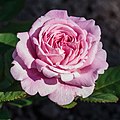Rosa 'Perfume Delight'
| Rosa 'Perfume Delight' | |
|---|---|
 Rosa 'Perfume Delight' | |
| Genus | Rosa hybrid |
| Hybrid parentage | 'Peace' x (('Rouge Meilland' x 'Chrysler Imperial') x 'El Capitan')[1] |
| Cultivar group | Hybrid tea rose |
| Marketing names | 'Perfume Delight' |
| Breeder | Swim & Weeks |
| Origin | United States, 1973 |
Rosa 'Perfume Delight' is a pink hybrid tea (HT) rose cultivar, bred by Herbert Swim and O. L. Weeks, Weeks Rose Growers, in 1973.[1] The rose was named an All-America Rose Selections winner in 1974.
Description
[edit]'Perfume Delight' is a bushy upright shrub, up to 4 ft (121 cm) in height with a 3 ft (91 cm) spread. Petals are typically 4-5 inches, with a high-centered, cupped form. Flowers open a deep rose and fade to pink. Blooms are rain resistant and have a strong, sweet fragrance. 'Perfume Delight' is a disease resistant plant, with large, glossy, leathery foliage. It thrives in USDA zone, 6 and warmer. The plant is almost continuously in bloom from spring through fall.[2]
'Perfume Delight' tends to have more black spot disease issues than its HT peers and even its own hybridized cultivars.[3]
Awards
[edit]- All-America Rose Selections winner, USA, (1974)[4]
Gallery
[edit]-
'Perfume Delight' tea rose bushes at Elizabeth Park Conservancy
-
'Perfume Delight' bud
-
'Perfume Delight' hybrid tea rose with misplaced white-color petal mutations
-
'Perfume Delight' hybrid tea rose with misplaced white-color petal mutations
-
'Perfume Delight' hybrid tea rose with double whorl and leaf color mutations
-
'Perfume Delight' hybrid tea rose with double whorl and leaf color mutations
-
'Perfume Delight' hybrid tea rose with leaf color and apex mutations
See also
[edit]References
[edit]- ^ a b "Perfume Delight". www.weeksroses.com. Weeks Roses. Retrieved 30 August 2024.
- ^ "Perfume Delight rose". Help me find roses, clematis, and peonies. Retrieved 3 August 2019.
- ^ Anderson, Nat (March 2012). "Blackspot". forum.rosehybridizers.org. Retrieved 30 August 2024.
we couldn't even keep 'Perfume Delight' alive because it was so black spot susceptible.
- ^ Quest-Ritson, Brigid; Quest-Ritson, Charles (2011). Encyclopedia of Roses (Reprint ed.). DK. p. 163. ISBN 978-0756688684.








